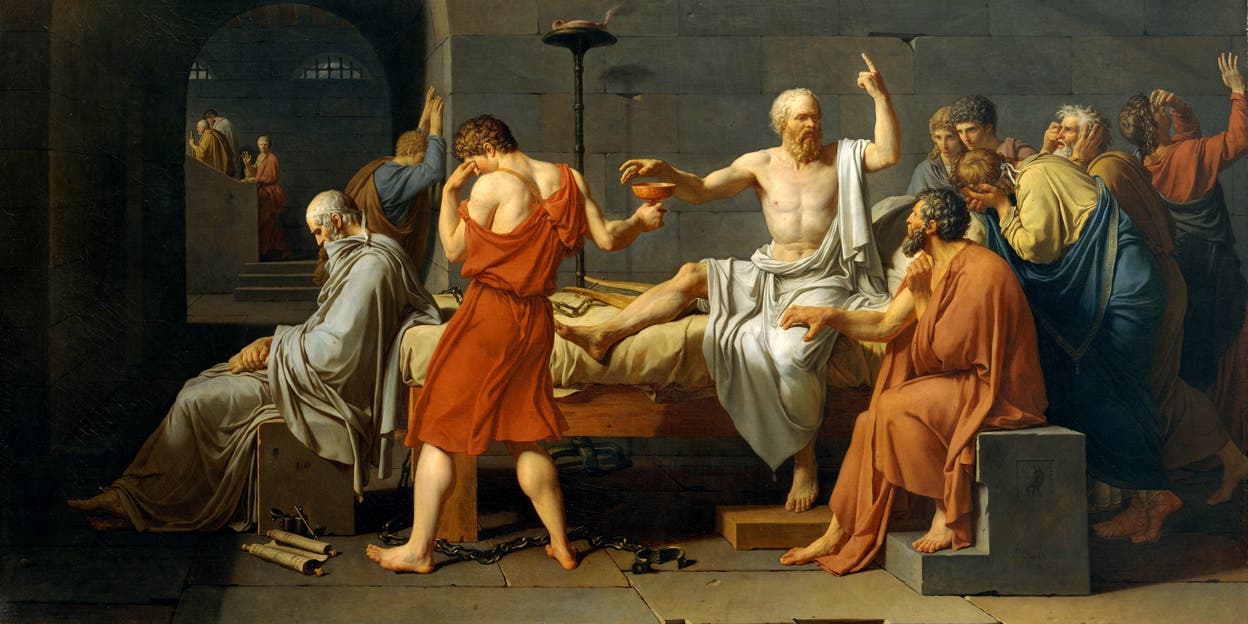
To philosophize is to learn how to die
Learning from Lecture Notes on an Ancient Idea by Dr Kurt Borg Art, EducationA few days ago I found myself in a lecture entitled: To philosophize is to learn how to die Notes on an Ancient Idea by Dr Kurt Borg
art education by Nataša Pantović
"To philosophize is to learn how to die" this is how Michel de Montaigne, the 16th century French writer puts it, quoting Cicero, who is thinking of Socrates condemned to death.

The Death of Socrates by French painter Jacques Louis David in 1787, the story of the execution of Socrates as told by Plato in his Phaed located in The Metropolitan Museum of Art
The founding figure of Western philosophy, Socrates (469-399 BC) left no writings, was the teacher of Plato and is best known for his style of teaching, asking question until his students arrived at own understanding. Socrates’ learning to die is bound with the question of the immortality of the soul. Socrates was accused of corrupting the youth of Athens and sentenced to death. He had to drink the cup of poisonous.
Socrates’ death is bound with the question of the immortality of the soul: how does one transcend it so as to come back resurrected, or immortal.
video Lecture: To philosophize is to learn how to die by Dr Kurt Borg
Michel de Montaigne’s “To philosophize is to learn how to die” was an essay he had published. Montaigne has lived through three tragedies in quick succession. His best friend died of the plague in 1563, not long after, his father and his brother died. Soon after he had a dangerous horse accident, Montaigne, who was a successful lawyer, retired from public life at the age of 38. Montaigne found himself terrified of his own death.
Montaigne says that he developed the habit of having death all the time with him. Montaigne tells us: “He who has learned how to die has unlearned how to be a slave.”
In this view, a life lived well, is one that comprehends death.
T.S. Eliot said, we have to see the skull beneath the skin.
Gustav Klimt’s large painting Death and Life, created in 1910, depicts the never-ending circle of life. Gustav Klimt was for this painting honoured with a first prize at the 1911 International Art Exhibition in Rome.

Death and Life (German: Tod und Leben) depicts an allegorical Life and Death in the Leopold Museum in Vienna
Klimt makes of it a modern dance of death, Instead of feeling threatened by the figure of death, his human beings seem to disregard it in images of pleasure or beauty.
Rather than ignore or try to deny death, Jung suggests we view it as a goal, the destination of the journey of the second half of life.
“…death is an important interest, especially to an aging person. A categorical question is being put to him, and he is under an obligation to answer it. To this end he ought to have a myth about death, for reason shows him nothing but the dark pit into which he is descending. Myth, however, can conjure up other images for him, helpful and enriching pictures of life in the land of the dead. If he believes in them, or greats them with some measure of credence, he is being just as right or just as wrong as someone who does not believe in them. But while the man who despairs marches toward nothingness, the one who has placed his faith in the archetype follows the tracks of life and lives right into his death. Both, to be sure, remain in uncertainty, but the one lives against his instincts, the other with them.” Jung (1959)






To philosophize is to learn how to die No comments on To philosophize is to learn how to die: